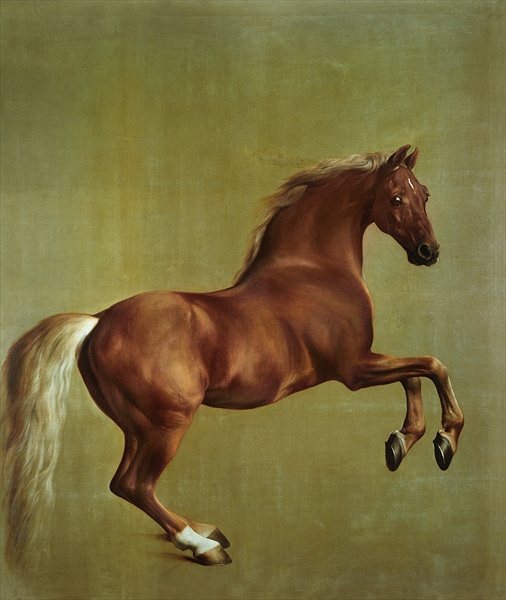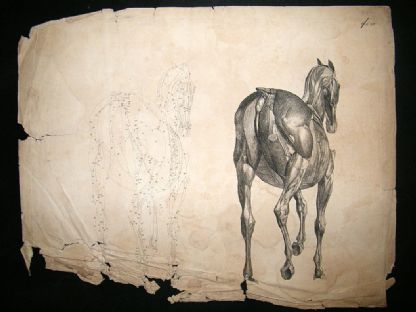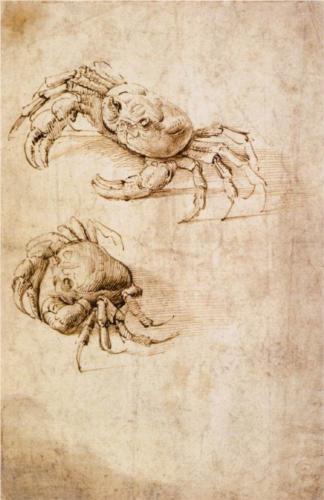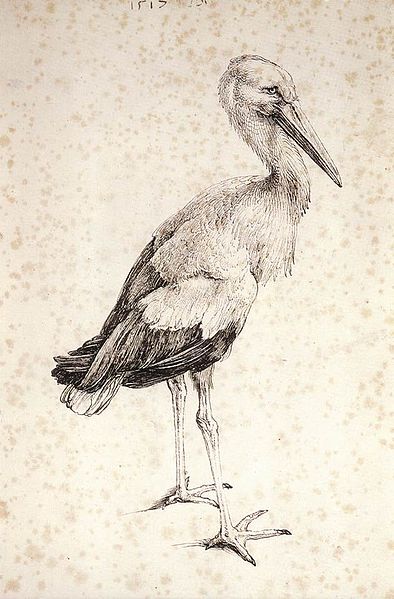I visited a local branch of Morrisons that apparently had a good, wide selection of fresh fish, and was not disappointed. I was at first tempted by the rainbow trout – perhaps for obvious reasons – but instead opted to spend a little more time studying the shapes, sizes and colours of all of the fish. The supermarket lights were making the decision harder, due to the excessive yellow in them, but after much deliberation I chose a sea bream; a wide-bodied fish, steely-grey with subtle markings in yellow and pink.
In my A3 sketchbook, I undertook a quick full-body study of the sea bream in biro to get a feel for its shape, as well as studying the body close-up and taking numerous colour notes from various parts. For example, there was a curious yellow-green marking on the head above the eye, and soft pinky-blue on the underbelly. I found this took studious observation in order to identify all of the colours on the body. When I was happy that I was ready to tackle the subject (my first drawing of a fish, in fact), I drew four rough compositions in both portrait and landscape format. I wanted to make sure I had sufficient light hitting the fish in order to show off the many iridescent colours, as well as enough shadow to give it a three-dimensional feel and provide tone and contrast. I found composition no. 4 more favourable than the others, as the head of the fish was bathed in light coming from the right and I had achieved an interesting foreshortening effect by coming down close to the floor and looking over the left (I chose the floor instead of the table for my background, for a change of scene…)
I selected a piece of A3 190gsm watercolour paper (in fact, the only type I had) and began with a very light drawing in HB pencil. Once I had done this, however, I felt the need to strengthen these lines with Winsor and Newton blue ink and a dip pen. This gave me a satisfying, crisp outline within which I could build up the colours and keep them contained. I was satisfied with the fact that there was almost equal negative space on either side of the plate, providing balance. Admittedly, at this point I found it a little tricky to get the proportions of the fish correct due to the foreshortening but continuously checked negative space and proportions of other areas as I drew, for assistance. The right-hand side of the plate is supposed to be closer to the viewer, therefore the leaf motif is more spread out.
Once the outline was in, I began with lighter colours on the body, using watercolour pencils; pink and light blue on the belly, yellow around the face, lilac and grey on the mid-body. I overlayed darker versions of these colours, varying pressure on the pencil where there were markings or shadows. The rest was almost done intuitively, with no necessary order, until I was happy with colour and tone. I used the eyes half closed technique to ascertain where the darkest areas should be (the eye and contour of the top of the body) and the lightest (the underbelly and tail). Using a fine water pen brush, I proceeded to merge the colours I had laid down, to create the shimmering effect. This is where I found the paper started to buckle, and I made a mental note to buy better quality in future.
I was aware that colour, rather than detail, was more important in suggesting the texture of the fish therefore I reduced the amount of marks I made, making only ‘suggestive’ ones to show scales on the mid-body. Once again intuitively, I flicked some of the blue ink I had used previously onto the head portion, for interest and texture. The plate and background were, I decided, to be kept fairly minimal so that the fish was the focal point; I added shadows to the plate using blue, purple and grey, with the background in dark grey and indigo to suggest the faux-stone effect of my floor.
Upon completing the drawing, I can see that my portrayal of shiny scales and the colours within them is rather successful, in that it suggests the texture and ‘wetness’ of the fish. Most fish appear mainly silver, and viewed from a distance this appears to be so but the colours are still all present. I paid close attention to the colours and feel I have stayed loyal to these and the structure of the sea bream in general. Perhaps not too convincing is the plate; the right-hand side doesn’t sweep correctly at the bottom, and due to the extreme viewpoint and foreshortening, I feel I have made it appear oval, as opposed to round.

Check and Log
- What were the main challenges of drawing animals? In this section, I have been challenged by drawing animals that I haven’t drawn before; horses, a cockerel and a fish have never featured in any of my previous work. I didn’t struggle a huge deal though as I applied the principles that I have learnt throughout the rest of the course; keen observational drawing, identifying shapes and negative space. What I did worry about was making the animals convincing enough, as there is a widely-accepted image in everyone’s mind of what a certain animal should look like.
- Which media did you enjoy using most and which did you feel were best for the subject matter and why? Using watercolour pencils properly for the first time drawing a fish on a plate was a learning curve; I had the pencils in my materials box but hadn’t used them for anything in particular – perhaps out of fear. the effect was a little unpredictable, probably as I hadn’t had a lot of experience, but they served me well in depicting the texture and colours satisfyingly. I cant imagine having used any other drawing media for the fish, and achieving the same iridescent effect.
- Where can you go to draw more animals? Think about the sorts of places that will give you opportunities for animal drawing. Have you tried drawing a moving animal yet? Places that come to mind are; the zoo, a pet shop, the park, other people’s houses (checking first, of course), animal shelters, theme parks/attractions, the seaside, in the woods…a lot more places than I had originally thought! I admit to being petrified about drawing a moving animal but I guess there is always the technique of contour or gestural drawing, where the movements can be built up over eachother and still portray a convincing likeness of an animal.
















